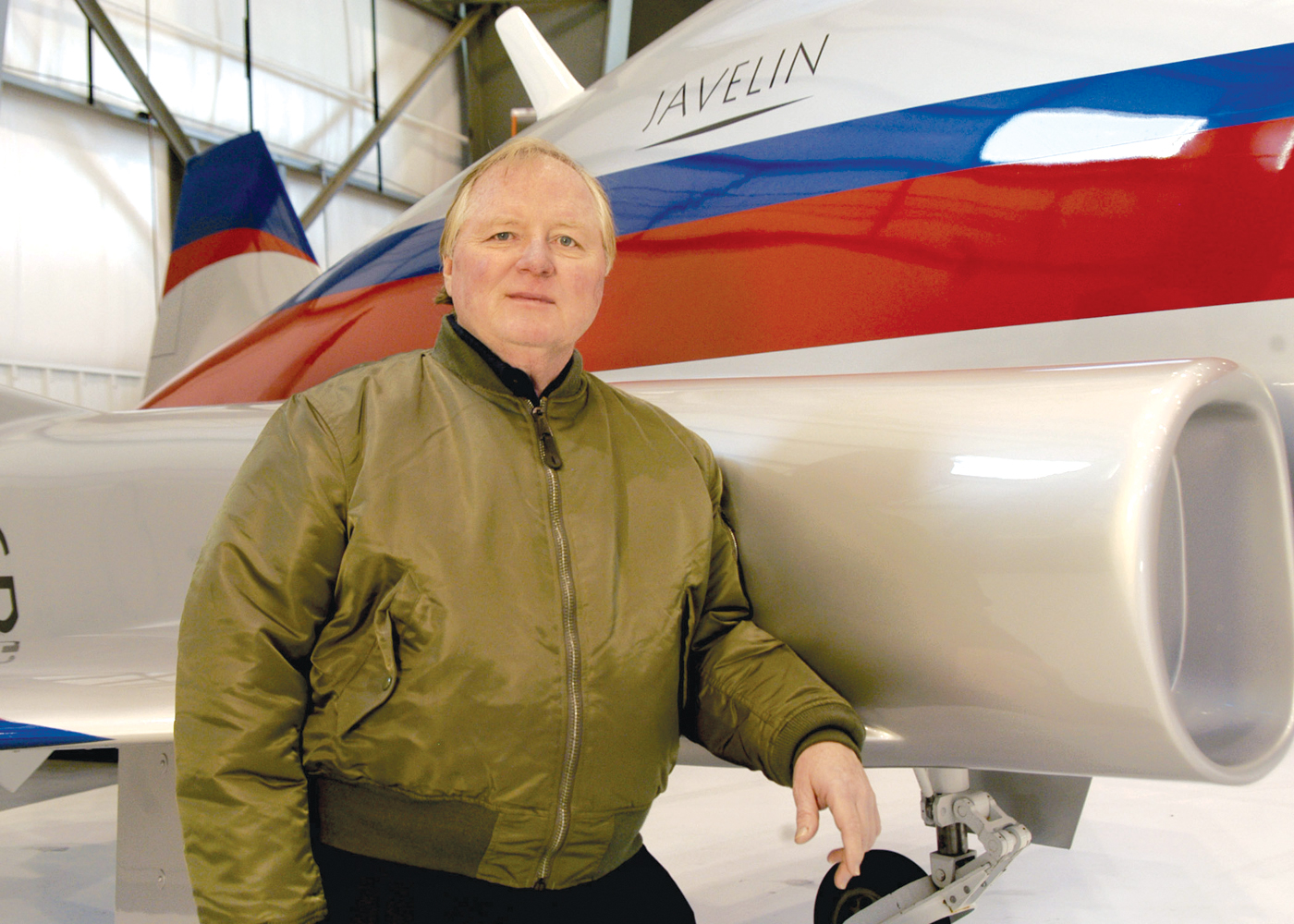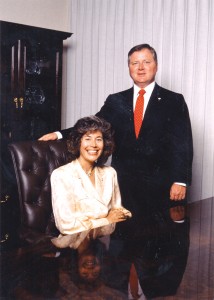By S. Clayton Moore

Dave Liniger, shown with the Javelin mock-up, is number three on the delivery schedule for Aviation Technology Group’s new sport jet.
In building RE/MAX International, Inc., Dave Liniger has taken a lot of risks, and he’s definitely left his mark on the world. He’s widely credited with doing more than anyone else in the real estate industry to change the working environment and bottom line of sales agents.
“RE/MAX” itself is an acronym for “real estate maximums,” a unique concept in risk sharing that gives the company’s owners, brokers and agents the highest possible compensation, as well as a wide variety of benefits such as educational opportunities. The idea changed the way homes are sold not only across the United States, but also internationally in the 50 countries in which RE/MAX operates.
The rewards have been tremendous. RE/MAX International is the largest privately owned real estate franchising company in the world, with nearly 20 percent of the U.S. real estate market. Last year was a milestone. The company not only has seen 384 months of consecutive growth, but also reached one of its largest goals in 2004. It ended the year by surpassing its goal to have 100,000 agents under the RE/MAX brand and announced a new corporate headquarters to be built in the Denver Tech Center. The news tops off 35 years of success for RE/MAX.
“RE/MAX is the most successful real estate network in history,” Liniger affirms. “It’s successful because the system works for the real estate agent, it works for the customer and it works for the broker who runs the office. Whether it was helping 100 agents in my own office or helping 100,000 agents across the network, we’ve definitely had a huge impact on this industry.”
Liniger, with his wife Gail, has created tremendous wealth, not only personally but also for the people who work hard for them. Despite his enormous business success, an uncommonly charitable heart and even a curtailed run for Senate last year, Liniger remains a remarkably down-to-earth man.
“We’re still doing the same things we always did,” he said. “We’ve stuck to the knitting and haven’t gotten lost going after 50 different ventures. We have the trappings of success, but that wasn’t why I did it. I did it because I wanted to create something beautiful. Then, the money came. I suspect that’s true of most people who build an organization this large. I think if you can find something to do with your life that you love you will be a success at it.”
Liniger’s dreams are analyzed in a new book, “Everybody Wins: The Story and Lessons Behind RE/MAX,” by authors Phil Harkins and Keith Hollihan. The authors originally set out to identify and study the top “high-growth, high-impact” public companies in the world, targeting those with at least 20 years of sustained annual growth, a strong global presence, a top-shelf reputation and a clear mission to be number one. They narrowed the list to Wal-Mart, McDonald’s, Nokia, BMW, Toyota and Canon. Then Harkins met Liniger and quickly realized that RE/MAX surpassed every company investigated in virtually every criterion save one: RE/MAX was private.
The story was too compelling to pass up. The authors interviewed hundreds of agents in detailing the story of Liniger and his company. John Wiley & Sons has printed over 150,000 copies of the book, which gives the first inside look at the company’s success.
“We’re an overnight success,” Liniger laughed, “But it took a whole lot of nights.”
Dreaming of adventure
Dave Liniger was born on Sept. 25, 1945, and grew up on the family farm in Marion, Ind., with what he calls, “The typical Midwest work ethic and those moral values.” While he learned early the value of hard work, he dreamed of better things. He read Louis L’Amour, studied John Wayne and watched “Tarzan” and “Sky King.”
“I grew up as this starry-eyed kid in a field thinking that there had to be more out there than the corn fields of Indiana,” he said. “I loved to hunt and fish and trap and I was after anything that looked like fun. I was certified to scuba dive when I was 10 years old. I really did make this conscious decision that I wanted a life of adventure.”
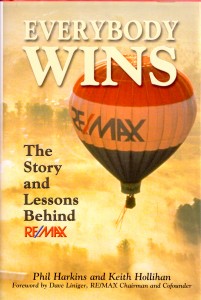
In “Everybody Wins,” authors Phil Harkins and Keith Hollihan get inside the RE/MAX story, its strategies and focus with unprecedented participation from Dave Liniger and his team.
His wisdom today is a big reversal from the person who left home at 17 to attend Indiana University.
“Unfortunately, I wasn’t very mature at that age. I didn’t have a goal,” he admits.
He dropped out after a couple of semesters. He met a girl and married her and decided to enter the U.S. Air Force.
“The military really gave me the chance to grow up,” he said. “It was fun. I thought it was a fabulous place. If I could have become an officer or made any kind of living at all, I would have stayed with it. I loved the camaraderie and being around airplanes and tanks and guns and the adventure of it all. It also taught me self-discipline and a sense of responsibility. I married young, had children and grew up very quickly, knowing I had to make a living for these kids.”
Everybody wins at RE/MAX
After leaving the military, Liniger redoubled his efforts. He started buying “fixer-uppers,” acquiring older houses for $10,000 and rolling them over a few months later at a profit. By the time he was 21, he owned 21 single-family homes and got his real estate license to dabble in sales.
Then, during one of many moments of doubt, Liniger met Dave Stone, a motivational speaker, who turned his life around.
“He was incredibly important to me. I was failing,” he explained. “I hadn’t made a single sale except for my own purchases. He was the best motivational speaker of his day in the real estate business. He really gave me confidence that I could do something important. I owe him a debt of gratitude.”
Liniger became good at sales, but he also developed his own vision. Moving his family to Denver, he imagined a company that would let agents keep 100 percent of their commissions, instead of splitting them with the managing organization. Agents would have a voice in running the office, but would also share the expenses of operating it. With that in mind, RE/MAX was founded in 1973.
“It started as a very basic real estate company here in Englewood,” Liniger said. “It grew to eight offices and we were number one in Denver by 1978, but it was a tough beginning. We didn’t have enough finances, our backers dropped out and the industry never wanted to see the thing succeed.”
The First Lady of RE/MAX
RE/MAX eventually did begin to succeed, but it cost him his first marriage, as well as the marriages of eight members of his senior staff. However, he gained a tremendous asset both personal and professional in his first employee.
“I interviewed 27 people trying to find an assistant to make this thing work,” he remembered. “My feeling was that my strengths were sales and managing and training. I needed to recruit the agents and act as a leader. I needed somebody who could open the offices, lease them, buy the furniture, set up the accounting and so on.”
He hired a sharp young woman named Gail Main, whose husband had been transferred from the Midwest. Over the past 30 years, the two have become the inseparable core of the RE/MAX family. While he pursued his vision, she built up the systems that make the company the clean-burning machine that it is today.
Her hiring reflects another difference in RE/MAX’s approach; they hired women. The top two real estate companies in Denver when RE/MAX was founded had no women agents at all.
“We’re a company that was virtually built completely by women. Five years into RE/MAX’s history in Colorado, over 70 percent of our sales force was made up of women agents,” Liniger confirmed.
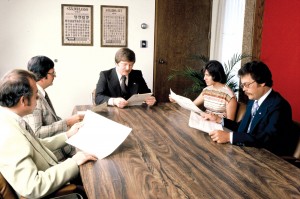
Dave Liniger admits the early years of RE/MAX were tough, but he has relied on a management team that has been with him an average of 30 years. L to R: Tim McBratney, Daryl Jesperson, Dave Liniger, Gail Liniger and Bob Fisher.
Over a decade later, the Linigers got married in the office, in 1984. It was a blessed event following a terrible turn of events; Gail was injured in a seaplane crash the previous year. His constant companionship, her indomitable spirit and three years of therapy in Denver’s Craig Hospital beat the odds. The woman who was never supposed to walk again still plays golf once or twice a week, albeit with only one good arm.
“It matured everybody in the company,” said Liniger soberly. “It was quite a struggle for her, but she overcame those obstacles. When Gail got hurt, we had been around for a decade and we were at about 3,000 agents. We were all now in our thirties and we were no longer the hell-raising, hard-drinking kids that we once were. It changed our perspective on the world.”
Burning rubber
Liniger has something of a reputation for his hard-working ways, and spent years coming in at 5 a.m., but in the mid-1980s, he learned to diversify his roles at RE/MAX.
“If I had stayed selling real estate for 35 years, I would have burned out a long time ago,” he said. “As it was, I sold real estate for four years, I ran my own offices for four years and then I had a franchising company. I’ve had the chance to stay fresh with lots of different jobs in the company and the day-to-day management is no longer something in which I have a lot of interest. I’ve always been able to hire better people than myself.”
That distance also allowed him to pursue his lifelong dreams of adventure and he did so with the same passion that he poured into his company. He learned to fly and golf and skydive. He built up a herd of hundreds of Arabian horses. He dived after World War II wrecks in the Pacific Ocean. He went big-game hunting in Africa and rekindled his love of wildlife.
He also found a new rush when Bill Marriott, the chairman of Marriott Hotels, invited him to the Bondurant Racing School in Arizona. While Liniger had raced jalopies as a kid, he had never experienced anything like professional racing.
“By the second day, I was beating the professionals’ times,” Liniger said with a grin. “I was very aggressive, but I didn’t know anything. I thought, ‘What the heck? I’m not too old for this yet.'”
Liniger started racing 10 years after the age most drivers retired, and like everything else he does, he didn’t start halfway. He started buying cars and eventually built up his own professional RE/MAX-sponsored NASCAR racing team.
“I didn’t want to drive a local track and bang fenders on Saturday nights like some townie,” he said. “I wanted to tour and I wanted to race with the best in the world. I got to meet them all and I got to race against most of them. It was a wonderful opportunity.”
RE/MAX Motorsports was no idle hobby. Although the team has since been disbanded, Liniger and his team were performing at the very edge of the sport. He blew a tire in a NASCAR race in Las Vegas and hit the wall doing 160 miles an hour. He walked away with two broken ribs.
“The sense of anxiety goes away after a while, and even after you break a rib or two, it’s no big deal,” he said. “Everybody totals three or four cars a year. When that green flag goes up, you’re in such a pack of cars with such concentration about when to brake and shift and who you can rub and who you can’t that you don’t even think about speed anymore.”
“Above The Crowd”
Liniger has taken his love of aviation gained in the U.S. Air Force and carried it into a number of aviation feats.
He travels over 200 days a year, working with RE/MAX offices around the globe. He started flying in 1980 to ease the strain of traveling, first with a Saratoga and then a Malibu. Today, he owns some amazing high-speed aircraft. He owns a Canadair CT-114 Tudor, a souped-up military version of the type flown by the Snowbirds acrobatic team. He also has a Falcon 2000 executive jet and is number three on the delivery schedule for Aviation Technology Group’s new Javelin sport jet. The planes are housed in RE/MAX’s new 40,000-square-foot hangar at Centennial Airport.
Then, you’ve probably seen at least one of the 90 seven-story hot air balloons that RE/MAX uses as a branding tool around the world. It’s the largest corporate balloon fleet in the world and gives a concrete image to the RE/MAX slogan, “Above The Crowd.” Strangely enough, Liniger didn’t even ride in one of his balloons until 1998. Even more ironically, he’s almost as well known for his 1998 attempt to circumnavigate the globe.
In December of that year, Liniger and Australian balloonist John Wallington had hoped to succeed where other attempts have failed by flying at the edge of space, 24 miles above the Earth, beyond normal weather patterns. In the process, the two men would’ve set new altitude records and become the first civilian near-space travelers. Although the flight from Alice Springs, Australia, was ultimately cancelled because of weather and mechanical problems, Liniger still sees it as a worthy effort.
“I’m still alive and it was one of the best adventures of my life,” he said. “It was never a publicity stunt. It was a real scientific attempt. Everybody got involved in this thing not because of the record, but because of a lot of curiosity about the human body. It was a fascinating attempt.”
The attempt, which took three years to plan and cost millions to try, would’ve put the two adventurers at 20,000 feet for over 20 days. It was a tremendous disappointment when the attempt finally ended in January 1999.
“There were two mornings where it looked like we could launch; both mornings we had thunderstorms roll in on top of us,” he recalled. “It was one of the few times that I’ve actually almost cried in public. We finally took the hatch off and there were 20,000 Australians who had come out to see us off with huge signs, American and Australian flags and bonfires, all waving and shouting.”
He also remembers one other critical thing about the flight.
“I was sitting in the capsule the day of the last attempt, and I was totally comfortable I could fly that bird,” Liniger said.
Finding sanctuary
Another joy the Linigers share is finding ways to make their good fortune work for those in need.
“I think when you get into the last third of your life, and you’ve been career-oriented the way we have, it’s not as satisfying,” he said. “You start looking at ways to get back to that satisfaction. Gail and I made a conscious decision. We obviously created a lot of wealth through our investment in this company. It isn’t my desire to have somebody in a foundation take whatever is left and give it away. I would much rather manage those resources while I’m alive and give that money where I think best.”
The couple and the company support numerous charities including Craig Hospital, Food Bank of the Rockies, the National Sports Center for the Disabled and the Susan G. Komen Breast Cancer Foundation. Much of their support originates with the 222-acre parcel of land they named Sanctuary, purchased in 1994.
“I built Sanctuary on a whim,” Liniger said. “I found a beautiful piece of land and it was going to be my horse ranch. I couldn’t get the contract pushed through for about two years, and in the meantime, Gail and I decided we should build a golf course on it. I wasn’t sure what to do with it.”
Instead, he let the land mature over more than a year, letting the property develop naturally and acting as a refuge for both the Linigers and the local wildlife.
Designed by renowned course architect Jim Engh, Sanctuary serves as a private oasis from residential development, and effectively complements 12,400 surrounding acres of dedicated open space. It’s one of the only 18-hole golf courses in the country that doesn’t accept members and it’s not open to the public. What Sanctuary does do is raise money for charity—lots of it.
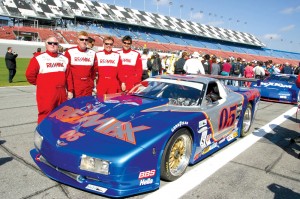
Although Dave Liniger has given up Team RE/MAX, he still races cars and motorcycles for fun. At the February 2003 Daytona 500.Dave Liniger, Craig Conway, John Metcalf and Rick Carelli.
“In the year that we let the site grow, RE/MAX agents from all over the state started sending me letters asking if we could have a charitable golf tournament here,” Liniger said. “Our people live in the same neighborhoods as the homes they sell and they’re all involved in different causes. In the first year, we had over 200 applications for charity fundraising events.”
It was spectacularly successful. In 2004, 22 charities hosted events at Sanctuary. Cumulatively they raised more than $4.4 million at Sanctuary bringing the eight-year total to more than $23 million raised through hosted events and donated foursomes at Sanctuary. RE/MAX works with a standard group of about 18 charities and rotates the remaining spots among newcomers.
“It was a defining moment for our company when we began searching through 200 charities,” he said. “We could only choose 20 or so and there were dozens of heartbreaking stories out there. It was difficult. Now we have a committee that gets together to select the new groups to be added. Our minimum goal is for each group to make at least $100,000 per day, net, and they do a great job. This group has it systemized and each year they get more and more money and bring in more people.”
Liniger’s presently trying to decide what will happen in a future career.
“The business will continue to grow and it will be a great story, but my next career will be to figure out what to do with the wealth we have created,” he said. “I have a lot of ideas and there are a lot of good causes out there.”
Breaking new ground
Sanctuary hasn’t been the only new development in the Linigers’ story. In 2002, they opened The Wildlife Experience, a 101,000-square-foot museum near Centennial Airport. It houses an extensive collection of natural history, paintings, sculpture, photography and film exhibits as well as a large-screen theater and a community center.
“There are tremendous environmental issues facing the world,” he said. “There are all kinds of people approaching it in different ways, but the issues are still there. When we created The Wildlife Experience, the whole idea was to make people aware of these conservation issues. I think it’s important that people understand its importance. It’s not the most important. There is hunger. There is AIDS. This is one area I’ve been fascinated with my entire life, so it’s an area I pay attention to. That’s kind of where my heart is,” Liniger said.
It was Liniger’s dedication to issues combined with his many resources that led state Republican leaders to encourage him to run for Senate in 2004. He gave it a lot of thought, but ultimately bowed out, leaving Pete Coors to run against Attorney General Ken Salazar, who won the race.
“I’m fortunate in that I have a good reputation and I get a lot of calls from politicians,” he said. “I’m conservative to a degree, but I’m very compassionate as well. There are a lot of parts to me. I think I could have been a viable candidate. It would’ve been interesting.”
After speaking with his wife and his four children, the gentleman from Castle Rock, Colo., decided it was too much.
“I couldn’t step away from RE/MAX; it’s my life,” he said. “I would’ve been forced to live in Washington four days a week, nine months out of the year. It’s a time in our life when we should be traveling less and it would’ve been awfully hard on my life. Politics would’ve been fun and I think I could’ve made a difference even if it was just one vote out of 100. It was a close call, but it’s okay.”
In December, RE/MAX announced that it would move into a new headquarters building in the Denver Tech Center in late 2006. Plans for the 250,000-square-foot building include 11 floors of office space above a six-story garage. The new headquarters will house corporate offices, the franchising division, and studio and operations space for the RE/MAX television network and training areas for the company, which is growing quickly and needs more space.

Dave Liniger’s Canadair CT-114 Tudor, a souped-up military version of the type flown by the Snowbirds acrobatic team, is based at Centennial Airport.
“If you look at our charts of agents by year, we’ve been growing by 10 to 15 percent year after year,” he explained. “To go from 1,000 agents to 1,100 isn’t that big a deal. To go from 87,000 to over 100,000 agents this year is a pretty significant number.”
He expects to gain another 50,000 agents in the next three years, and he invests a significant amount of his time teaching and training staff across the globe. Every single one of the company’s agents has Dave Liniger’s personal e-mail address and he reads every single e-mail.
“We’ve always been conscious that we need to have a strong bench of players that can go in anywhere, anytime,” he said. “Somebody who has been with you 20 years understands that this is the way you do business and this is the way we treat customers. There’s another layer down who are 25 to 35 years old who have been here two to 10 years. Those are the people with whom I spend my time. They are who our senior officers mentor. It’s no accident who they have dinner with or whose golf cart they ride in. We are specifically looking at each individual thinking about how to impart as much of our knowledge and ideals as we can,” Liniger explained.
One staff member who will be retiring is CEO Daryl “Jes” Jesperson, who will step down in October 2005, but who will still take part in company activities. Current President Margaret Kelly will work closely with Jesperson until his retirement and will assume the duties of CEO on October 1. Do these events give Liniger thoughts of retiring himself? Not a chance.
“Me? I’m madly in love with what I do,” he said. “I would pay to have this job. The hard years were trying to build it up. Now we have the wherewithal to make a difference. I enjoy the people who work with me and I enjoy the people in the field. I really enjoy the real estate community. It’s a unique industry in that most people are very honest. If you’re around for very long, you know who the good guys are.
“We’ll fight tooth and nail to get a listing, but we’re unique in that people who fought to get that listing now make it available to everybody to get it sold. The people who become successful real estate agents become successful not just because they work hard. They are good people. They like their customers and they like what they do. They’re fun to be around. This is a wonderful industry.”











